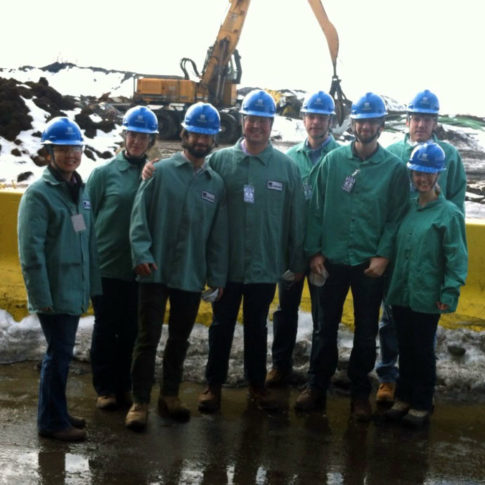
RAND's Structural Team at the Gerdau steel mill in Sayreville, NJ, where scrap metal is repurposed into steel reinforcing bars used in construction.
Today is SteelDay, an annual event sponsored by the American Institute of Steel Construction to educate the public on how the structural steel industry contributes to building America. As an engineering student in college, every day was steel day for me. I learned the basic science of how steel is made and studied its properties and many uses. But it wasn’t until recently that I had the opportunity to witness steel being manufactured and see firsthand the power behind this magnificent metal.
Earlier this year, my RAND Structural team members and I took a field trip to visit Gerdau’s steel mill in Sayreville, NJ. Gerdau, a 110-year-old company with more than 45,000 employees worldwide, manufactures more than 25 million metric tons of steel a year in 14 countries. At this New Jersey plant they melt old scrap metal to create steel reinforcing bars, also known as rebar, used in buildings, bridges, tunnels, roads, dams, and other types of concrete construction.
Gerdau’s steel manufacturing process starts with scrap metal, which is separated by its composition. Everything from car parts to kitchen appliances comes from all over the region to the plant to be reused. At the mill, a crane operator grabs scrap pieces from different piles and drops them onto a conveyor belt leading to the main burner. The scraps selected depend on the type of steel being produced and what it will be used for as determined by engineers who specify the steel based on its strength, resistance to corrosion, and ability to be welded.
Once in the burner, the scrap metal is melted into 2,000° F molten steel and poured into molds. The chemical composition is finalized by adding metal alloys, such as chromium, directly to the molten mix. After coolingfor a couple hours, the hardened steel is removed from the mold as 30-foot long square rods called billets.
We walked across a catwalk over the billets as they were removed from the molds and passed under cascading water to slowly cool them. Even from our perch 30 feet above, we could feel the immense heat that the steaming billets generated. After the billets are sufficiently cooled, they are moved to the fabricating side of the plant, where they are rolled like pieces of spaghetti into long round rods, which are then cut and transformed into finished products, ready for shipping.
Stepping behind the scenes and observing just a fraction of the energy required to melt metal and create steel left me in awe at the sheer power of the process. While most of the heavy lifting is performed by big equipment operated by skilled technicians at a safe distance, each machine has its own choreography and precision. The pride that the Gerdau employees take in creating a product widely used all over the world was evident throughout the mill.
The tour also reinforced my belief that while a new or renovated building may look sleek and elegant on the outside, its most impressive feature is its underlying structure and the sweat and grit that went into forging it. By reclaiming discarded products and transforming them into the materials that support the buildings we work on every day, Gerdau gave me and my RAND structural team members an even greater appreciation for a material that is so integral to our profession.

One Response to Steel Away